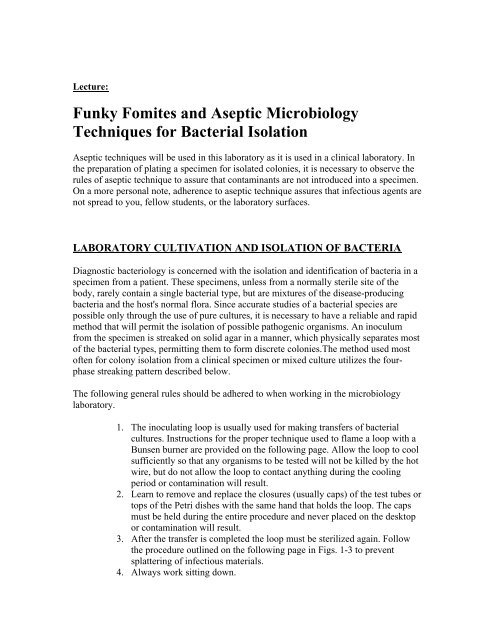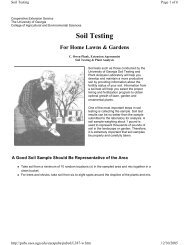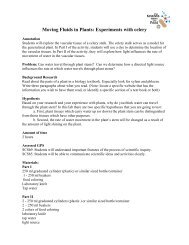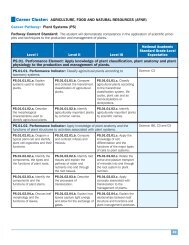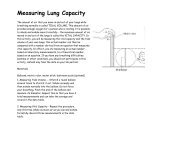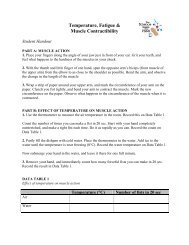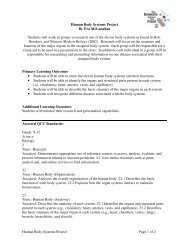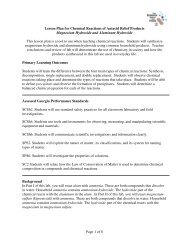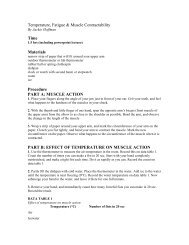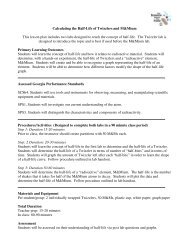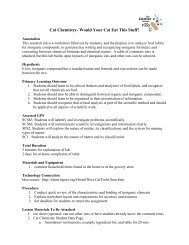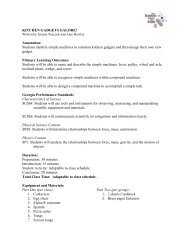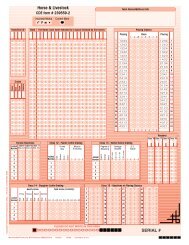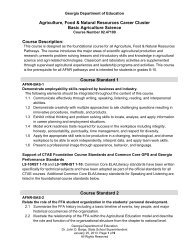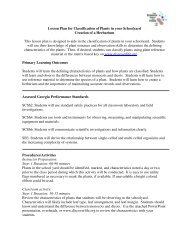Funky Fomites and Aseptic Microbiology Techniques for Bacterial ...
Funky Fomites and Aseptic Microbiology Techniques for Bacterial ...
Funky Fomites and Aseptic Microbiology Techniques for Bacterial ...
You also want an ePaper? Increase the reach of your titles
YUMPU automatically turns print PDFs into web optimized ePapers that Google loves.
Lecture:<br />
<strong>Funky</strong> <strong>Fomites</strong> <strong>and</strong> <strong>Aseptic</strong> <strong>Microbiology</strong><br />
<strong>Techniques</strong> <strong>for</strong> <strong>Bacterial</strong> Isolation<br />
<strong>Aseptic</strong> techniques will be used in this laboratory as it is used in a clinical laboratory. In<br />
the preparation of plating a specimen <strong>for</strong> isolated colonies, it is necessary to observe the<br />
rules of aseptic technique to assure that contaminants are not introduced into a specimen.<br />
On a more personal note, adherence to aseptic technique assures that infectious agents are<br />
not spread to you, fellow students, or the laboratory surfaces.<br />
LABORATORY CULTIVATION AND ISOLATION OF BACTERIA<br />
Diagnostic bacteriology is concerned with the isolation <strong>and</strong> identification of bacteria in a<br />
specimen from a patient. These specimens, unless from a normally sterile site of the<br />
body, rarely contain a single bacterial type, but are mixtures of the disease-producing<br />
bacteria <strong>and</strong> the host's normal flora. Since accurate studies of a bacterial species are<br />
possible only through the use of pure cultures, it is necessary to have a reliable <strong>and</strong> rapid<br />
method that will permit the isolation of possible pathogenic organisms. An inoculum<br />
from the specimen is streaked on solid agar in a manner, which physically separates most<br />
of the bacterial types, permitting them to <strong>for</strong>m discrete colonies.The method used most<br />
often <strong>for</strong> colony isolation from a clinical specimen or mixed culture utilizes the fourphase<br />
streaking pattern described below.<br />
The following general rules should be adhered to when working in the microbiology<br />
laboratory.<br />
1. The inoculating loop is usually used <strong>for</strong> making transfers of bacterial<br />
cultures. Instructions <strong>for</strong> the proper technique used to flame a loop with a<br />
Bunsen burner are provided on the following page. Allow the loop to cool<br />
sufficiently so that any organisms to be tested will not be killed by the hot<br />
wire, but do not allow the loop to contact anything during the cooling<br />
period or contamination will result.<br />
2. Learn to remove <strong>and</strong> replace the closures (usually caps) of the test tubes or<br />
tops of the Petri dishes with the same h<strong>and</strong> that holds the loop. The caps<br />
must be held during the entire procedure <strong>and</strong> never placed on the desktop<br />
or contamination will result.<br />
3. After the transfer is completed the loop must be sterilized again. Follow<br />
the procedure outlined on the following page in Figs. 1-3 to prevent<br />
splattering of infectious materials.<br />
4. Always work sitting down.
Class Notes:<br />
5. Attention to details <strong>and</strong> practice will allow you to work both rapidly <strong>and</strong><br />
accurately.<br />
<strong>Microbiology</strong> <strong>Aseptic</strong> <strong>Techniques</strong>:<br />
-Used when isolating bacterial colonies<br />
-Ensures that contaminants are not introduced into the specimen being studied<br />
-Ensures that the person working with a bacterial sample is protected from infectious<br />
agents.<br />
Instruments Used When Practicing <strong>Aseptic</strong> Technique:<br />
1) Flaming/Innoculating Loop: used <strong>for</strong> making transfers of bacterial cultures<br />
2) Bunsen Burner: flammable gas source <strong>for</strong> sterilization of loop <strong>and</strong> bacterial<br />
source<br />
3) Sparker: creates the spark needed to ignite the gas from the Bunsen burner<br />
4) Petri dish: contains media that will act as a nutrient source <strong>for</strong> bacteria, bacteria<br />
are plated onto a petri dish which is then incubated so that bacterial growth may<br />
occur<br />
5) Media: may be liquid or gelatinous: is the nutrient source utilized by bacteria <strong>for</strong><br />
growth<br />
6) Broth- liquid nutrient source <strong>for</strong> bacteria<br />
7) Agar-gelatinous nutrient source <strong>for</strong> bacteria<br />
8) Luria Broth: general type of media that allows all types of bacteria to grow<br />
Selective vs. Differential Media:<br />
- Selective Media: has a specific nutrient source or pH that allows <strong>for</strong> the<br />
growth of certain bacteria while inhibiting the growth other bacteria<br />
- Differentail Media: allows different types of bacteria to grow BUT<br />
enables the scientist to distinguish or differentiate between types of<br />
bacteria
<strong>Bacterial</strong> Morphology:<br />
Cocci (circular)<br />
Bacillus (rods)<br />
Spriochetes (spiral)<br />
Gram Negative vs. Gram Positive Bacteria:<br />
Gram Positive Bacteria: Bacteria that are gram-positive are<br />
stained dark blue or violet by Gram staining, in contrast to<br />
Gram-negative bacteria. The stain is caused by a higher<br />
amount of peptidoglycan in the cell wall, which typically lacks<br />
the secondary membrane <strong>and</strong> lipopolysaccharide layer found<br />
in other bacteria.<br />
The largest group of Gram-positive bacteria are the<br />
Firmicutes; well-known genera include Bacillus, Listeria,<br />
Staphylococcus, Streptococcus, Enterococcus, <strong>and</strong><br />
Clostridium. Other major groups include the Actinobacteria,<br />
Planctomycetes, Deinococci, <strong>and</strong> Thermotogae.<br />
Gram Negative Bacteria:<br />
Bacteria that are gram-negative are not stained dark blue or<br />
violet by Gram staining, in contrast to gram-positive bacteria.<br />
The difference lies in the cell wall of the two types; grampositive<br />
bacteria have a high amount of peptidoglycan in their<br />
cell wall which the stain interacts with, while gram-negative<br />
bacteria have a cell wall made primarily of lipopolysaccharide.<br />
The gram-negative cell wall is similar to a cytoplasmic<br />
membrane, typically only a few layers thick <strong>and</strong> generally<br />
much thinner than gram-positive types.<br />
Many species of gram-negative bacteria are pathogenic. This<br />
pathogenic capability is usually associated with certain<br />
components of their cell walls, particularly the<br />
lipopolysaccharide (endotoxin) layer.<br />
The proteobacteria are a major group of gram-negative<br />
bacteria, including <strong>for</strong> instance Escherichia coli, Salmonella,<br />
<strong>and</strong> other Enterobacteriaceae, Pseudomonas, Moraxella,
Terminology:<br />
Helicobacter, Stenotrophomonas, Bdellovibrio, acetic acid<br />
bacteria, <strong>and</strong> a great many others. Other notable groups of<br />
gram-negative bacteria include the cyanobacteria,<br />
spirochaetes, green sulfur <strong>and</strong> green non-sulfur bacteria.<br />
Zoonoses- transmission of a disease from an animal to a human<br />
Translucent- a material that one can see through<br />
Turbidity- a material that one cannot see through; usually indicates that bacterial growth<br />
has occurred<br />
Flora- natural bacterial inhabitants in the body<br />
Indigenous- native to that habitat, one’s normal flora<br />
Pathogenic (noxious)- harmful, disease causing agent<br />
Innocuous- not harmful<br />
Aerobic- requires oxygen to grow<br />
Anaerobic- does not require oxygent to grow<br />
Amorphous- having no definite shape<br />
Laboratory Procedure:<br />
FLAMING A LOOP<br />
Heat from the base of the wire first (Fig. 1) <strong>and</strong> slowly move towards the loop (tip) (Fig.<br />
2). Heat the wire until it is red-hot (Fig. 3).
BACTERIAL COLONY ISOLATION<br />
Step 1. Using a sterile loop, streak cultures (liquid broth) over one-fourth of the surface<br />
of an agar plate. Then flame the loop as described on the preceding page.<br />
Step 2. Air cool a flamed loop or cool it by touching an unstreaked area of agar on the<br />
same plate.<br />
Step 3. Pass the cooled loop three or four times over the initial streaked portion of the<br />
plate. Streak it, without overlap, to the next quadrant.<br />
Step 4. Flame the loop <strong>and</strong> allow it to cool as described above in Step 2.<br />
Step 5. Pass the loop over the streaked portion of the second quadrant two or three times<br />
<strong>and</strong> then streak the material without overlapping over the third quadrant of the plate.<br />
Step 6. Repeat Step 5 to streak the last quadrant.<br />
Most bacteria do not move appreciably from the sites of inoculation but give rise there<br />
toclones of bacteria called colonies. Isolated colonies should arise in the third <strong>and</strong><br />
fourthquadrants depending on the concentration of bacteria in the initial inoculum.
STREAKING BACTERIA FOR COLONY ISOLATION
List of Possible <strong>Fomites</strong> <strong>for</strong> Swabbing:<br />
- toilet bowl rim<br />
- water fountain<br />
- bathroom door h<strong>and</strong>les<br />
- sink h<strong>and</strong>les<br />
- cafeteria lunch counter<br />
- baseball hats<br />
- laboratory bench tops<br />
- desk tops<br />
- gym lockers<br />
LABORATORY REPORT QUESTIONS:<br />
1) What is the purpose of aseptic technique?<br />
2) Why do scientists need to isolate bacterial colonies from a specimen?<br />
3) What is the procedure used to flame a loop?<br />
4) What is the procedure used to streak <strong>for</strong> bacterial isolation?<br />
5) What are some safety precautions you should take when using a Bunsen<br />
burner?


